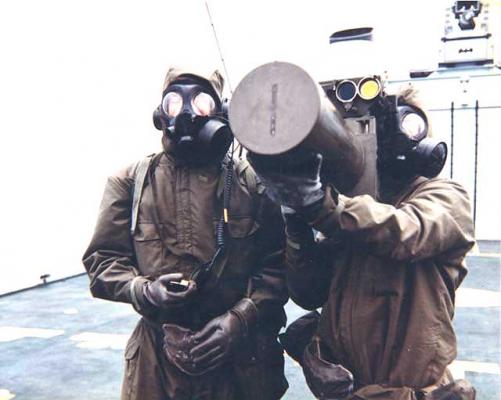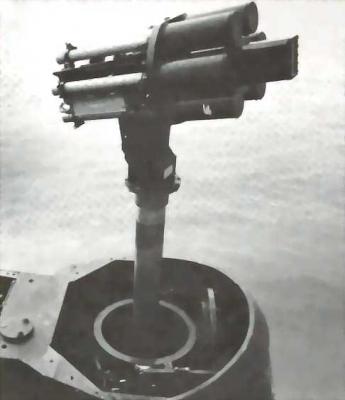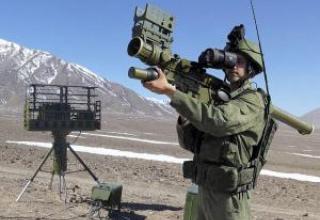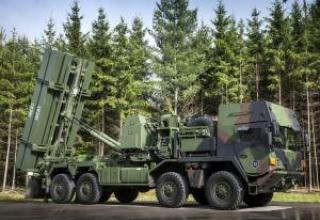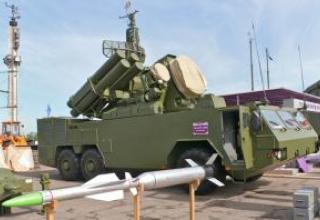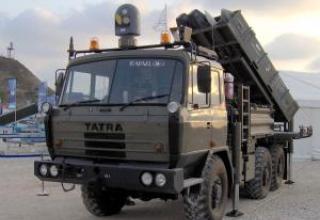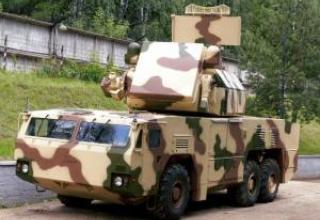Portable anti-aircraft missile system (MANPADS) "Blowpipe" is designed to combat subsonic aircraft and enemy helicopters at ranges up to 3 km and altitudes up to 1.8 km. The system can also be used to destroy ground and surface light armored targets at ranges up to 3 km.
Blowpipe" complex was developed by "Shorts Missile Systems" (Belfast Northern Ireland). Tests of the complex began in 1965, in September 1966 - was presented at the international exhibition in Farnborough.
The Blowpipe man-portable air defence system uses a radio command guidance system. This complex is more complex to handle than man-portable air defence systems with infrared homing heads. The operation of the radio line and tracer on the missile demystifies the guidance process and the location of the firing position, the use of manual control leads to a strong dependence of the efficiency of the complex on the degree of training and psychophysical condition of the operator. The advantage of the complex is the possibility of confident firing of various types of air targets at extremely low altitudes.
Series production of Blowpipe complex by order of the Ministry of Defence of Great Britain began in 1968, in early 1972 the complex was adopted for service. British Army air defense battalions armed with Blowpipe man-portable air defence systems include two platoons, three divisions with four man-portable air defence systems in each.
In 1979, a semi-automatic guidance system for the Blowpipe complex was successfully tested. Modernized version, called "Javelin", was adopted in 1984. The "Blowpipe" rocket can be used with "Javelin" sighting equipment. By the end of 1989, 19000 Blowpipe missiles were produced, and mass production was completed. The complex is in service in Afghanistan, Argentina, Canada, Chile, Ecuador and Malaysia. The Thai Air Force has a twin LCNADS launcher, equipped with a telescope sight, which can be placed on a light chassis or ground.
Composition:
Blowpipe" complex combat vehicles are placed in the launcher, on it, and attached to the back of the operator. The time to put the complex on alert is 20 seconds.
Means of guidance of the complex include:
- pointing unit (monocular sight, as well as a pointing handle, which the operator moves with his thumb);
- counting and solving device;
- a radio command transmission station aboard the ZUR.
The last two devices are attached behind the operator's back. An electric battery is mounted in the unit to power the guidance unit and the on-board equipment of the RSD (before starting it). The weight of the guidance unit mounted on the launcher is 3.6 kg.
The functions of the detection and target designation system are performed by the operator, who with the naked eye or using the fivefold optical monocular sight detects and identifies targets and selects one of them for firing. Targeting can also be transmitted to the operator by radio from a detection and target designation system. When a target is selected, the operator begins to follow it using the sighting field of view, and moves with the launcher on his shoulder. The operator then switches on the equipment, selects the frequency of the command transmitter and the type of fuse to be used. When the target enters the launch area (which is also visually determined by the operator), he launches the ZUR. After the ZAR is launched, the operator "grabs" its tail tracer in the sight of the sight, with the help of which he already accompanies the target, and, by manipulating the guidance handle, seeks to align the missile with the target, thus guiding the ZAR using the "cover the target" method. Angular mismatches between the track of the SAM and the target sighting line are fed into the guidance counting and resolving device, and the commands generated by it are fed to the missile via a radio command transmission station (dimensions 129x152x91 mm), where they are implemented. If the guidance commands are not received on board the missile during the first five seconds of the flight, the self-destruct device is triggered. For safety reasons, special protective clothing is provided for the operator.
The launcher of the complex includes a transport and launch container (TLC) and a firing mechanism. Designed on the principle of minimization of recoil at gunshot, the TPC consists of two cylindrical tubes, with the front having a larger diameter. When the firing is completed, a new missile launcher is attached to the firing mechanism instead of the empty container, and the empty container can be used again. A telescopic stand can be attached to the launcher to facilitate the operator's work. The ZUR transport and launch containers placed in special boxes can be dropped by parachute.
Single-stage anti-aircraft guided missile "Blowpipe" is made on the aerodynamic scheme "duck". The missile has no detachable parts in flight and is unusual in that its nose part, which houses the control system and the fuse, freely rotates along the longitudinal axis relative to the missile body. Stabilizers fastened together in a single unit can move along the missile body. Before the launch, they are in the forward position (in the part of the larger diameter container), after the launch they slide along the rocket body to the rear position, where they are automatically secured with latches. Shrapnel and high-explosive combat unit (weight 2.7-3.6 kg) located in the central part of the SAM is equipped with shock and non-contact infrared fuses.
The RDTT has two traction modes: starting and marching. Launch mode fuel is burned during the movement of the SAM in the PIC (within 0.2 seconds), ensuring that the missile is removed at a safe distance for the operator (about 25 m). After that, the marching mode is automatically activated. To reduce the smoke effect on the march mode, special fuel is used and gases are extracted through special holes. The effective range of the missile is limited by speed and maneuverability in the final flight section after the engine is switched off.
The Blowpipe complex can fire aircraft from the ground, car, ship and underwater from a submarine at periscope depth.
Complex "SLAM" (Submarine-Launched Air Missile System) (see diagram) was developed by the British firm Vickers in the early 1980s for self-defense of 500-1100 tons of submarines from anti-submarine helicopters, aircraft and small surface ships.
The complex includes a stabilized multi-charge launcher with six Blowpipe missiles, a control and guidance system, a television camera, and a monitoring and verification system. Targets are detected by the submarine periscope. Pointing of the "SLAM" launcher at the target along the azimuth is carried out synchronously with the periscope rotation, after that the operator of the complex searches for the target at the corner of the place and takes over the control of the complex by pressing a special button in the pointing handle and disconnecting the drives of the periscope and the "SLAM" launcher. After the launch, the rocket is accompanied by a TV camera and is guided to the target by the operator with the help of the guidance handle.
The azimuth pointing angle is 360°, the angle of position is from -10° to +90°. Guidance accuracy is ± 0.5°. Azimuth rotation speed of the launcher is 40 degrees Celsius, angle of position is 10 degrees Celsius. Application of the complex "SLAM" is allowed at wind speed up to 37 km/h, water temperature from 0 to 55 ° C, sea disturbance up to 4 points.
The SLAM complex was installed on three Israeli Agosta class French-made submarines.
Characteristics:
| Defeat range, km | 0.7 - 3.5 |
| Defeat height, km | 0.01 - 2.5 |
| The diameter of the rocket, mm | 76 |
| The length of the rocket, mm | 1346 |
| Wingspan, mm | 267 |
| Maximum missile speed | 1.5М |
| Mass of the rocket, kg | 11.0 |
| Missile warhead weight, kg | 2.2 |
| Mass of the rocket in the TPC, kg | 14.5 |
| Weight of sighting unit, kg | 6.2 |
Testing:
The Blowpipe complex was used during the Anglo-Argentine conflict over the Falkland Islands, on both sides. On May 21, 1982, during the landing at San Carlos Bay, a detachment of 30 Argentine soldiers using man-portable air defence systems "Blowpipe" shot down 2 British landing helicopters. On the same day, a Blowpipe missile hit Lieutenant Jeffrey Glover's Harrier. The pilot ejected. The total losses of Argentina's Air Force from Blowpipe man-portable air defence systems amounted to 9 aircraft.
In spring 1986, "Blowpipe" complexes entered Afghanistan, where they were used by Afghan mujahideen, mainly to defeat armored personnel carriers. The effectiveness of the complex against aircraft, compared to man-portable air defence systems "Stinger", was not high.
Sources:
- Пересада С.А. "Зенитные ракетные комплексы" Военное издательство Министерства обороны СССР, Москва, 1973 г.
- Василин Н.Я., Гуринович А.Л. "Зенитные ракетные комплексы" .-Мн.: ООО "Попурри", 2002- 464с.
- SLAM - Submarine-Launched Air Missile System
- Вестник ПВО
